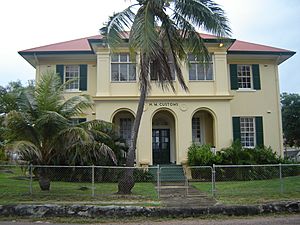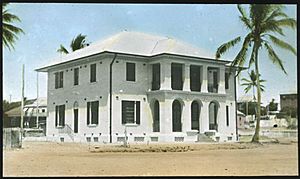Thursday Island Customs House facts for kids
Quick facts for kids Thursday Island Customs House |
|
|---|---|

Thursday Island Customs House, 2006
|
|
| Location | 2 Victoria Parade, Thursday Island, Shire of Torres, Queensland, Australia |
| Design period | 1919 - 1930s (interwar period) |
| Built | 1938 |
| Architect | Harold Barker |
| Architectural style(s) | Georgian |
| Official name: Thursday Island Customs House | |
| Type | state heritage (built) |
| Designated | 7 February 2005 |
| Reference no. | 601527 |
| Significant period | 1938 (fabric) 1942-1945 (historical) |
| Significant components | fence/wall - perimeter, cannon, customs house, flagpole/flagstaff, trees/plantings, garden - ornamental/flower |
| Lua error in Module:Location_map at line 420: attempt to index field 'wikibase' (a nil value). | |
The Thursday Island Customs House is a special old building located at 2 Victoria Parade on Thursday Island in Queensland, Australia. It was designed by an architect named Harold Barker and finished in 1938. This building is important because of its history and unique design. It was added to the Queensland Heritage Register on 7 February 2005, which means it is protected for future generations.
A Look Back in Time
This two-story building is made of stone and covered with a smooth finish called stucco. It was built in 1938 for the Australian Government's Customs Department. It replaced an older customs house that was built way back in 1885.
Early Days of Thursday Island
Thursday Island has a long and interesting history. The local Aboriginal people called it "Waiben Island." Europeans first visited the area in 1606. Famous explorers like Captain Cook and William Bligh also sailed through these waters later on.
In 1872, the Queensland government took control of the islands in the Torres Strait. Thursday Island became an important settlement in 1877. People hoped it would grow because it was a key stop for ships traveling between Australia, Asia, and England. It was also a busy center for the pearl and sea cucumber industries. The government also wanted a strong presence here to show other countries, like Germany and France, that Australia was in charge.
Why Customs Houses Were Important
Back then, it was very important for the government to have customs offices at all major ports. The customs service collected taxes, called duties, on goods coming into the country. This money helped pay for important things like roads and buildings in the new settlements. Each part of Australia had its own customs service. When Australia became a united country (Federation), collecting customs duties became the job of the national government.
The First Customs House
In 1877, Thursday Island was officially named a "Port of Entry and Clearance." This meant ships had to report here when arriving or leaving. The first Customs House was built in 1885. It was made of timber and had one story with a veranda all around. It had offices for customs work and a special "long room" where people did business. This first building was located at the corner of Douglas and Hastings streets.
The port was very busy, especially with the pearling industry. Many pearl boats from Asia and Japan worked in the Torres Strait. Customs officers had to keep track of these boats and other trading ships. The port also welcomed immigrants and ships stopping to refuel. Thursday Island was a major gateway to Australia, often the first stop for ships arriving from Asia.
A New Building for a Busy Port
In 1938, a new, larger Customs House was built. This showed how important the port still was. The new building was made of brick and concrete and had two stories. The ground floor was for customs offices, and the second floor was where the customs officer in charge lived. This new building cost a lot of money and became one of the most noticeable buildings on the island. It was built right next to the old timber customs house, which was then moved away.
The Customs House During World War II
Soon after the new Customs House was built, World War II began in 1939. In January 1942, many people who weren't essential workers had to leave Thursday Island. Customs officers found their work almost stopped. Later in 1942, the military took over the Torres Strait and used the Customs House as a home for the Commander of the Torres Force until the war ended in 1945.
After the War
The Customs House went back to the Customs Service in 1946. The building had been empty for a few months after the military left. An officer from Cairns visited Thursday Island to check on things. He noted that many people from Malaysia still lived on the island, and it was still an "open door to the East." He thought it was important to have a customs officer there to handle customs, immigration, and shipping rules.
Over the years, the Customs Service on Thursday Island continued its work. The Customs House was used by the Australian Customs Service for a long time until it was no longer owned by the government. It remains a famous building on the island, being one of the few buildings not made of timber.
What the Customs House Looks Like
Thursday Island is a tropical island in the Torres Strait, located between the northern tip of Cape York and New Guinea. The Customs House is in a very noticeable spot in the town, right on the southern coast. It's a two-story stone building facing Victoria Parade, with Hastings and Jetty streets on its sides. The Government Jetty and Engineers Jetty are also nearby. This building stands out because it's one of the few on the island not made of wood.
Design and Style
The former Thursday Island Customs House is built in a style called Neo-Georgian, which was popular in the 1930s. It's a two-story building with a smooth, rendered finish. It has balconies at the front and back and a roof that slopes down on all sides, covered with terracotta tiles. The windows have timber shutters, which are common in tropical places.
Inside the Building
The way the building is laid out is typical for customs houses from that time. The main part of the ground floor is the "Long Room," where most of the customs business was done. You enter the building through the front to reach this room. Smaller offices, including one for the sub-collector (the person in charge), are located around this main room. On the first floor, there was a home for the sub-collector, with bedrooms, living areas, and other rooms.
The arcades (covered walkways) and balconies were not just for looks. Upstairs, the balcony gave a protected and airy living space, which was very important in the hot, tropical climate. Double doors from the rooms inside often opened onto the balcony, letting in cool breezes. The Thursday Island Customs House has timber shutters on its balcony openings.
The building's style, sometimes called "Stripped Classical," kept important classical features like balanced shapes and fronts. However, it removed much of the fancy decoration usually found on classical buildings. Any decorations used were often in the Art Deco style.
Outdoor Areas
The Customs House has a lot of open space around it on three sides. This allows for clear views of the large building, making it look even more important in the area. The grounds are mostly flat, with open lawns and a few old trees. A line of tall palm trees adds to the building's special look. A concrete path leads from the front steps to a gate in the fence. There's also a path along the front of the building. Flower beds are planted between the building walls and this path. Another path leads to a small concrete area on the eastern lawn, where a flagpole and a small cannon are placed. Paths also extend from the two side entrances to gates at the property lines.
The Thursday Island Customs House is similar in size and shape to the Cairns Customs House.
Why This Building is Special
The Thursday Island Customs House was listed on the Queensland Heritage Register on 7 February 2005 because it meets certain important standards.
It shows how Queensland's history developed. The former Thursday Island Customs House is important because it shows how the government worked in a far-off place like Thursday Island. It also highlights the island's strategic importance to both the colonial and national governments. The Customs House shows how important Thursday Island was as a "gateway" to Queensland and later to Australia.
It is a good example of a certain type of building. This building is a great example of the "stripped Classical" style of government buildings. This style was used by the Commonwealth Department of Works between World War I and World War II.
It is beautiful and well-designed. The Thursday Island Customs House is beautiful because of its design. It is especially good at handling the hot climate of North Queensland. It also adds to the look of Thursday Island as one of the largest and one of the few non-timber buildings there. The tropical plants around the building make it even more attractive.



